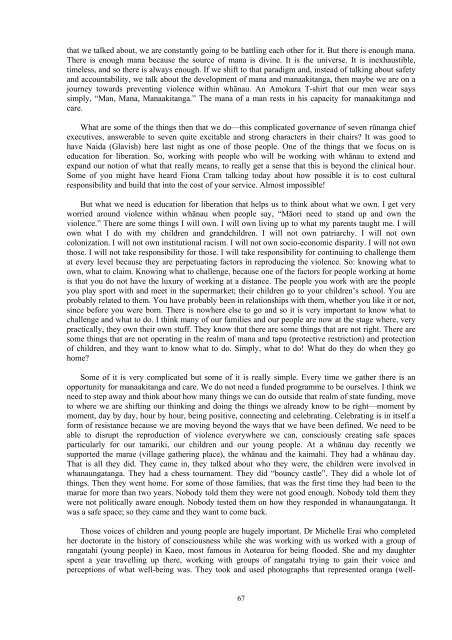traditional knowledge conference 2008 te tatau pounamu
traditional knowledge conference 2008 te tatau pounamu
traditional knowledge conference 2008 te tatau pounamu
Create successful ePaper yourself
Turn your PDF publications into a flip-book with our unique Google optimized e-Paper software.
that we talked about, we are constantly going to be battling each other for it. But there is enough mana.There is enough mana because the source of mana is divine. It is the universe. It is inexhaustible,timeless, and so there is always enough. If we shift to that paradigm and, ins<strong>te</strong>ad of talking about safetyand accountability, we talk about the development of mana and manaakitanga, then maybe we are on ajourney towards preventing violence within whānau. An Amokura T-shirt that our men wear sayssimply, “Man, Mana, Manaakitanga.” The mana of a man rests in his capacity for manaakitanga andcare.What are some of the things then that we do—this complica<strong>te</strong>d governance of seven rūnanga chiefexecutives, answerable to seven qui<strong>te</strong> excitable and strong charac<strong>te</strong>rs in their chairs? It was good tohave Naida (Glavish) here last night as one of those people. One of the things that we focus on iseducation for liberation. So, working with people who will be working with whānau to ex<strong>te</strong>nd andexpand our notion of what that really means, to really get a sense that this is beyond the clinical hour.Some of you might have heard Fiona Cram talking today about how possible it is to cost culturalresponsibility and build that into the cost of your service. Almost impossible!But what we need is education for liberation that helps us to think about what we own. I get veryworried around violence within whānau when people say, “Māori need to stand up and own theviolence.” There are some things I will own. I will own living up to what my parents taught me. I willown what I do with my children and grandchildren. I will not own patriarchy. I will not owncolonization. I will not own institutional racism. I will not own socio-economic disparity. I will not ownthose. I will not take responsibility for those. I will take responsibility for continuing to challenge themat every level because they are perpetuating factors in reproducing the violence. So: knowing what toown, what to claim. Knowing what to challenge, because one of the factors for people working at homeis that you do not have the luxury of working at a distance. The people you work with are the peopleyou play sport with and meet in the supermarket; their children go to your children’s school. You areprobably rela<strong>te</strong>d to them. You have probably been in relationships with them, whether you like it or not,since before you were born. There is nowhere else to go and so it is very important to know what tochallenge and what to do. I think many of our families and our people are now at the stage where, verypractically, they own their own stuff. They know that there are some things that are not right. There aresome things that are not operating in the realm of mana and tapu (pro<strong>te</strong>ctive restriction) and pro<strong>te</strong>ctionof children, and they want to know what to do. Simply, what to do! What do they do when they gohome?Some of it is very complica<strong>te</strong>d but some of it is really simple. Every time we gather there is anopportunity for manaakitanga and care. We do not need a funded programme to be ourselves. I think weneed to s<strong>te</strong>p away and think about how many things we can do outside that realm of sta<strong>te</strong> funding, moveto where we are shifting our thinking and doing the things we already know to be right—moment bymoment, day by day, hour by hour, being positive, connecting and celebrating. Celebrating is in itself aform of resistance because we are moving beyond the ways that we have been defined. We need to beable to disrupt the reproduction of violence everywhere we can, consciously creating safe spacesparticularly for our tamariki, our children and our young people. At a whānau day recently wesuppor<strong>te</strong>d the marae (village gathering place), the whānau and the kaimahi. They had a whānau day.That is all they did. They came in, they talked about who they were, the children were involved inwhanaungatanga. They had a chess tournament. They did “bouncy castle”. They did a whole lot ofthings. Then they went home. For some of those families, that was the first time they had been to themarae for more than two years. Nobody told them they were not good enough. Nobody told them theywere not politically aware enough. Nobody <strong>te</strong>s<strong>te</strong>d them on how they responded in whanaungatanga. Itwas a safe space; so they came and they want to come back.Those voices of children and young people are hugely important. Dr Michelle Erai who comple<strong>te</strong>dher doctora<strong>te</strong> in the history of consciousness while she was working with us worked with a group ofrangatahi (young people) in Kaeo, most famous in Ao<strong>te</strong>aroa for being flooded. She and my daugh<strong>te</strong>rspent a year travelling up there, working with groups of rangatahi trying to gain their voice andperceptions of what well-being was. They took and used photographs that represen<strong>te</strong>d oranga (well-67
















